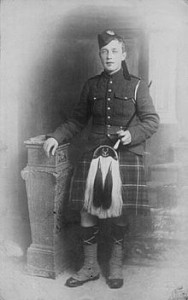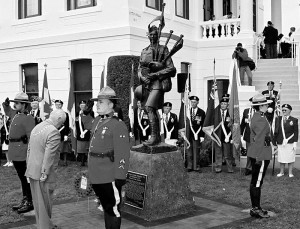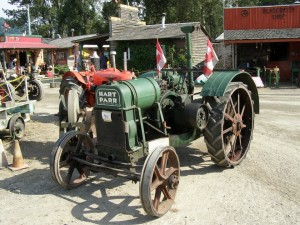The historic town of Yale, BC is a nice RV destination from Chilliwack, just an hour (75 km) up Highway #1. Yale holds a uniquely important place in British Columbia history which is the main attraction, but today Yale is also a cute little town of just a couple hundred people in amazing surroundings.
History Linked to Transportation
The rise and fall and rise and fall again of Yale in importance parallels changes in transportation needs. While the modes of transportation changed over time – from pack horses, to wagons and steam boats, before the rails of steel arrived and then the Trans-Canada Highway with its cars and trucks – Yale is on the way somewhere important.
Yale’s Unique Geography
Yale is right on the Fraser River and generally considered to be the dividing line between the Interior and Coastal regions of British Columbia. Yale also stands at the southern end of the Fraser Canyon and in the days of steam wheelers it was the end of the navigable river beyond which no one wanted to take their boat into whitewater. In a reversal of objectives, today whitewater river users seek the thrills of rafting upstream of Yale, with several rafting companies using Yale as their southern base.
The Hudson’s Bay Company Fort
While the natives lived in the Yale area for thousands of years, the Hudson’s Bay Company set up Fort Yale in 1848 in response to being cut off from the mouth of Columbia River by the Americans, leading to a greater emphasis on the Fraser River as a route to the sea. The boundary dispute resulted in the United States gaining the portion of the Columbia District south of th 49th parrallel and the eventual creation of Washington and Oregon States. British Columbia is literally the “British” part of the HBC Columbia District. The “fort” was just a single log building with no stockades designed as a HBC trading post. The fort was also designed to supply the needs of the passing fur brigades. This new little trading post was named it after James Murray Yale, the current Chief Factor (General Manager) of the Hudson’s Bay Company Columbia District. The first manager of Fort Yale was Ovid Allard. The HBC effort at Yale proved a huge failure. That first year the brigades travelling on the new trail through Fort Yale lost one man, 70 of 400 horses, and 25 valuable loads to the rough conditions. The Company adjusted, creating a more southern route was created and anchored by Fort Hope. Yale fell into disuse for the next decade.
Gold! and a Wagon Road
The discovery of gold in the Fraser River changed Yale from a small ignored fort into a boom town. Since Yale was the head of river navigation, it was the logical location to start of the Cariboo Wagon Road in 1861. Completed speedily in 1863, the Cariboo Wagon Road ran up to the gold fields of Barkerville via Lytton, Ashcroft and Quesnel. Contractors used pick and shovel working under the supervision of the Royal Engineers on one of the largest projects in the British Empire at the time. 400 miles of new road blasted into the interior of the province was critical to opening up BC to settlement, with the Cariboo Wagon route remaining the key north-south transportation spine of the province over 150 years later. Today you can still see small sections of the original Cariboo Wagon Road. Historic Hat Creek Ranch is one of the best places to step back in time because there you can ride a stage coach along the road during the tourist season. However, we all still use the road when we drive the Trans-Canada Highway (Highway 1) from Yale to Cache Creek, then Highway 97 north through the Cariboo as these important highways largely follow the original route (which is why so little of the origional road remains).
Yale as a Boomtown
In its heyday at the peak of the gold rush, Yale was reputed to be the largest city west of Chicago and north of San Francisco. It also earned nicknames such as “the wickedest little settlement in British Columbia” and “a veritable Sodom and Gomorrah” of vice, violence and lawlessness. Yale played an important role in the gold rush. In those days the town had a busy dockside life as well as a variety of bars, restaurants, hotels, saloons and various services – both legal and illegal. Yale was home to 5-8,000 people, but peaked out at about 15,000 during the evacuation of the Canyon during the Fraser Canyon War of 1858.
By the start of the 1870s, an overland route from the Mainland capital of New Westminster to Yale was finally built. Following the south side of the river, it was formally called the Grand Trunk Road but commonly and still called called the Yale Road and in some places Old Yale Road. If you drive through Surrey, Langley, Abbotsford, Chilliwack and Hope you will find surviving sections of the Highway labeled with the Yale or Old Yale name. Yale Road’s counterpart on the north side of the river was the Dewdney Trunk Road.
Post Gold Rush
Because of its unique role as a transshipment point for the Cariboo Wagon Road, Yale prospered for another twenty years after the gold rush. Although it declined in population, it retained some prestige and sophistication that existed within the rough gold town days. In addition to lending its name to the main highway through the fertile Fraser Valley, Yale was the namesake of government and electoral districts reaching into the vast developing interior of the province.
Rails of Steel
First the Canadian Pacific Railway, and later the Canadian Northern brought a new boom to Yale. However the CPR construction ran directly through the village and destroyed the town’s old commercial core. Yale had good transportation connections to New Westminster and the railway’s terminous on Burrard Inlet (to become the biggest city in the Province, Vancouver) so Andrew Onderdonk made it his construction headquarters and residence. The railway brought jobs, men and money to Yale. Three-times daily rail service to Vancouver – begun in the early 1880s before construction in the Canyon was finished in 1885 – made Yale a popular excursion run. With construction ended, however, the population dropped dramatically in Yale and continued to decline afterward. Daily return service by rail remained in effect until World War I. When Onderdonk moved on in 1886, he donated his estate for the All Hallows girl’s school, ranked as one of the main society schools in BC. The school operated into the 1920s. Today it is a RV campground.
New Highways
Construction of the railway destroyed parts of the Cariboo Wagon Road, cutting off Yale from Boston Bar and also between Lytton and Spences Bridge. The new highway north from Yale was not built until the 1922 when the Cariboo Highway was constructed often on the grade of the original wagon road. After major reconstruction of the Cariboo Highway in the 1950s, involving the construction of several major tunnels, the difficult old canyon stretch of the route achieved highway quality (instead of in name only), and Yale boomed once again. 1949 saw a push to create a continuous highway to knit an expanded Canada (Newfoundland became the last province) together by road. The Trans-Canada Highway Act brought upgrades to the route through Yale. For a long time Highway #1 through Yale was the main route between the Interior and the Coast and beyond to the rest of Canada. Transportation themed Expo 86 in Vancouver saw another push to improve transportation in BC, with the Coquihalla Highway and Skytrain as the flagship projects. Although the new highway was designated #5 in 1985 and the route through Yale remained the official Trans-Canada, practically the Coquihalla route was a faster, safer and shorter way to Kamloops and beyond. The shift in traffic patterns hurt Yale’s economy and population fell off as the major part of traffic bypassed the Fraser Canyon route.
Yale Today
Most of Yale’s current population are members of the Yale First Nation. Businesses include a couple of stores, restaurants and a few motels and other services, as well as gas stations, and automotive repair. Several Fraser River rafting expedition companies have waterfront campgrounds and facilities near Yale. The site of the All Hallows school is now a campground and hostel.
Not much of gold rush-era Yale survives, as the docks vanished long ago. The railway that created one of the town’s booms plowed right through the flat section of land that formed downtown and divided Yale’s remaining buildings from the river access formerly enjoyed.
The Yale Museum and Historic Site is located on old Front Street, adjacent to the tracks. Next to it is the Anglican Church of St. John the Divine, among the oldest in British Columbia.
Trips like Historic Yale are perfect if you store your RV in Chilliwack.



 Beside the Chilliwack Museum are two interesting objects. In the triangle to the south is one of Chilliwack’s cenotaphs where annual Remembrance Day ceremony’s are held. On the east side is a statute of Piper Richardson, a Chilliwack boy awarded the VC Cross for his gallant action in October 1916. The Victoria Cross is the highest and most prestigious award for gallantry in the face of the enemy that can be awarded to British and Commonwealth forces.
Beside the Chilliwack Museum are two interesting objects. In the triangle to the south is one of Chilliwack’s cenotaphs where annual Remembrance Day ceremony’s are held. On the east side is a statute of Piper Richardson, a Chilliwack boy awarded the VC Cross for his gallant action in October 1916. The Victoria Cross is the highest and most prestigious award for gallantry in the face of the enemy that can be awarded to British and Commonwealth forces.

